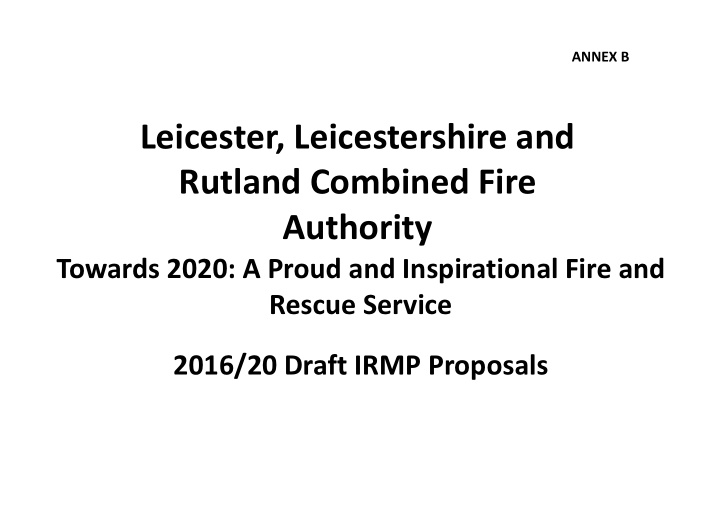



ANNEX B Leicester, Leicestershire and Rutland Combined Fire Authority Towards 2020: A Proud and Inspirational Fire and Rescue Service 2016/20 Draft IRMP Proposals
Myth Busting • Firefighter and public safety will be put at risk – ‘Cuts Cost Lives’? • Finance and debt - Selling HQ will solve the financial problems? • Increases in population, dwellings and traffic - Capacity to manage increasing number of incidents? • The reduction in fire engines – We will not be able to resource large incidents and will have no resilience? • Operational effectiveness will be compromised - Tactical Response Vehicle’s are vans equipped with pressure washers? • Consultation process – It is not legally compliant?
Modelling • Risk Methodology Externally verified by Risktec – “ The work carried out by LFRS in developing the methodology and datasets to produce the Risk Methodology is a robust and comprehensive piece of work, presenting data in a manner which is both transparent and easy to understand.” • Fire Engine Travel Times Road Type determined by Ordnance Survey Mastermap Integrated Transport Network (ITN) Road speed is based on a 3 year average of actual road speeds achieved by fire engines responding to incidents
Community Risk Model Based on lower super output areas (LSOA) 5 years of incident data, including: • Building fires • Road traffic collisions • Life risk special service • Fatalities • Casualties As well as indices of multiple deprivation
Tactical Response Vehicles (TRV) Example of Tactical Response Vehicles used in other service areas Specifications: Advantages: • Two crew members Low cost and relatively short lead time compared • • Water capacity between 150 – 200 to standard fire appliances litres with foam capability Small and versatile off road capable vehicle • Retains some fire-fighting capability • • Dedicated four wheel drive Attendance at incidents for scene assessment and • • Cost circa £50,000 intervention, resolving many small incidents Multi purpose – can be used for Emergency First • Responding More fuel efficient than standard fire engines • Fewer crew increases availability, at a lower cost •
Tactical Response Vehicles Used or being considered by (not exhaustive): • West Midlands • South Yorkshire • West Yorkshire • Humberside • Devon and Somerset • Staffordshire • Tyne and Wear • Durham and Darlington • Cheshire Suited for small fires and initial activity at other incidents. Used in conjunction with traditional fire engines at property fires. Technical specifications vary dependant on risk profile.
Tactical Response Vehicles No. and % of incidents per year by station area as well as retained fire engine availability, averaged over five years (2010-15) Retained Primary Property Station Area All Other Incidents Total Fire Engine Fires Availability Coalville 41.2 8.6% 438 91.4% 479.2 96.5% Melton 33.4 10.7% 277.6 89.3% 89.1% 311 Mowbray Billesdon 3 6.5% 43.2 93.5% 46.2 74.2%
Fire Engine Demand Average time spent dealing with incidents Annual Average Minutes No. Percent 0-15 2991 35.6% 15-30 3342 39.8% 30-60 1470 17.5% 60-120 442 5.3% 120-240 85 1.0% 240+ 71 0.8% Total 8402 100.0% Based on time of call to time stop message received
Loughborough Incident Profile Incident Type 1 2 3 4 5 5+ Total False Alarm 196.8 131.6 2.4 0.0 0.0 0.0 330.8 Primary Fire 37.6 45.6 5.6 1.0 0.5 0.8 91.1 Secondary Fire 82.4 6.6 0.2 0.0 0.0 0.0 89.2 Special Service Other 62.0 13.2 0.8 0.2 0.0 0.0 76.2 Special Service RTC 11.2 20.4 0.6 0.0 0.0 0.0 32.2 Grand Total 390.0 217.4 9.6 1.2 0.5 0.8 619.5 Central Incident Profile Incident Type 1 2 3 4 5 5+ Total False Alarm 342.0 217.4 123.8 113.8 1.4 0.0 798.4 Primary Fire 34.0 43.0 29.8 13.6 3.4 1.6 125.4 Secondary Fire 157.2 6.0 1.4 0.4 0.0 0.0 165.0 Special Service Other 123.8 16.4 1.4 0.4 0.2 0.0 142.2 Special Service RTC 14.8 19.2 0.4 0.0 0.0 0.0 34.4 Grand Total 671.8 302.0 156.8 128.2 5.0 1.6 1265.4
Current Response Capability (Includes Over the Border) SHEPSH ED WESTER N
Future Response Capability (Includes Over the Border) SHEPSH ED WESTER N
Consultation Activity Consultation commenced 25 September 2015, closes 4 December 2015 (10 weeks) Communicated electronically through email, social media and website Over 2,100 stakeholders contacted via email including business, community and statutory organisations Over 10,000 accessed details via Facebook 10 Public Engagement Events attracting approximately 710 attendees 2 additional events planned at Coalville and Loughborough in November Wholetime and On-Call employees engaged with Extensive press coverage
Consultation – Responses Key Points from Engagement Events: Increase in council tax precept • Government funding reductions • Fewer resources affecting resilience • Other fire and rescue authorities shrinking • reducing support Fewer firefighters available • No fire engines within the city centre • Tactical Response Vehicles are untested and is not a • fire engine Unsighted on rejected proposals • Headquarters – options of use •
Consultation – Responses Responses received as at 3 November 2015 are as follows: 1,088 Questionnaires submitted 13 Freedom of Information requests 89 Enquiries of which: 61 Emails 14 Phone calls 8 Letters 3 Social media comments 3 Visits
Leicester, Leicestershire and Rutland Combined Fire Authority Towards 2020: A Proud and Inspirational Fire and Rescue Service 2016/20 Draft IRMP Proposals
Recommend
More recommend